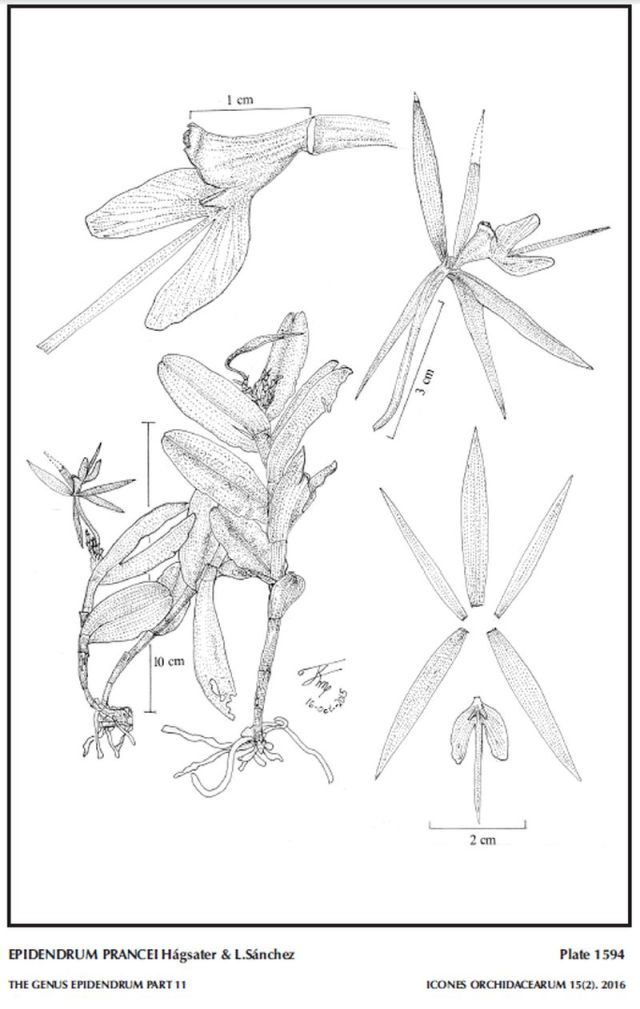

Epidendrum prancei Hágsater & L.Sánchez 2016 GROUP Nocturnum
TYPE Drawing by © R Jimenez M and The AMO Herbaria Website



Common Name Prance’s Epidendrum [British Botanist former director of Royal Batanical Garden at Kew, Brazilian orchid collector current]
Flower Size 2.4” [6 cm]
Found in Amazonas state of Brazil at low elevations as a small sized, hot growing epiphyte with simple, cane-like, ancipitous towards the apex, occasionally tinged with purple, straight stems carrying 4 to 6, all along the apical 3/4’s of the stem, densely aggregate, coriaceous, ovate-elliptic, unequally bilobed, minutely mucronate, venation and dorsal keel evident leaves that blooms in the fall but most likely year round on a terminal, without a spathe, racemose to pluriracemose, peduncle .2 to .28” [5 to 7 mm] long, rachis .4 to .6” [1 to 1.5 cm] long, successively single, several flowered inflorescence with much shorter than the ovary, embracing, triangular, acuminate floral bracts and carrying resupinate flowers with pale green sepals, white lip and petals and yellow calli.
"Epidendrum prancei belongs to the GROUP Nocturnum which is characterized by the sympodial, caespitose plants, cane-like, non-fusiform stems, successive flowers on a short, racemose or pluri-racemose inflorescence, without spathaceous bracts, and large, star-shaped flowers, with similar sepals and petals; the flowers are mostly indistinguishable in shape. The species is recognized by the ancipitose stems towards the apex, leaves wide and short (length:width 2 to 3:1), 2.4 to 3.8" x 1.2" [6.0 to 9.5 x 3.0 to 3.5 cm]; stems and leaves green, occasionally tinged purple, ovary 1.62 [40 mm] long, column .48" [12 mm] long, calli laminar, acute, prominent, divergent, column arched widely upwards. It is similar to Epidendrum erectum which is found in the Planalto Central of Brazil, in the states of Minas Gerais and Goiás, but that species has taller stems, 1.2 to 3.4" [30-90 cm] tall, narrower leaves, .48 to 1" [1.2-2.5 cm] wide, (length:width= 2 to 4:1), ovary 1.8 to 2.4" [45-60 mm] long, column .6 to .92" [15-23 mm] long, straight and calli laminar, quadrate, parallel. Epidendrum nocturnum Jacq., widely distributed from Florida to Bolivia, has green plants, terete stems, leaves distributed along the apical 2/3 of the stems, larger flowers, sepals and petals 1.4 to 3" [35-75 mm] long, ovary 2 to 3.2" [50-80 mm] long, straight to arching downwards, body of the capsule centered and occupying most of its length. Epidendrum tumuc-humaciense (Veyret) Carnevali & G.A.Romero is endemic to the Guyana Shield and the northern Amazon basin in Colombia, Venezuela, Guyana, Surinam, French Guyana and northern Brazil; its plants are wine-red or yellowish green, with numerous short and narrow leaves .12 to .348" x .48 to 1.08" [3 to 9.2 x 1.2 to 2.8 cm], distributed throughout the stems, those towards the base of the stem larger, sepals and petals 1.92 to 3.24" [48 to 81 mm] long, ovary generally 3.2 to 4" [80 to 100 mm] long, column .76 to 1.08" [19 to 27 mm] long, straight to arching downwards, and the body of the capsule occupying the apical half of the pedicelate ovary. Epidendrum spruceanum Lindl. is found at the base of the Andes in Brazil and Peru, from Manaus to Puerto Meléndez, plants are larger and the stems laterally compressed, leaves large and wide (length:width= 2 to 4:1), generally .4 to .7" x 1.8" [10 to 17.5 x 2.0 to 4.5 cm], sepals and petals 1.92" to 2.8" [48 to 70 mm] long, column .48 to .8" [12 to 20 mm] long, straight, calli laminar and parallel." Hagsater etal 2016
Synonyms
References W3 Tropicos, Kew Monocot list , IPNI ; *Icones Orchidacearum 15 [2] Plate 1594 Hagsater & Sanchez 2016 drawing fide;
--------------------------------------------------------------------------------------------------------------------------